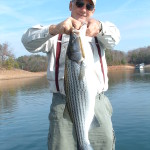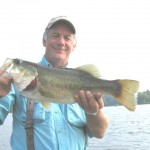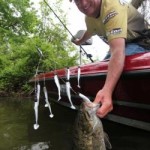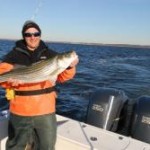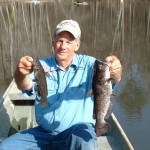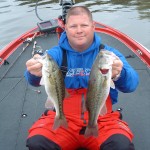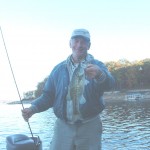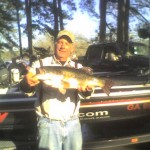White bass, stripers and hybrids are all closely related and are in the Morone family of fish. They are true bass, unlike black bass that are actually in the sunfish family. White bass are a freshwater species, stripers are a saltwater fish that spawns in fresh water and hybrids are a man-made cross between the two.
White bass are not native to Georgia waters but have been stocked here since Allatoona and Lanier filled. They can reproduce naturally in both lakes so they are no longer stocked. The average size is about a pound but they get much bigger. The world record white bass weighed 6 pounds, 13 ounces and was caught in Virginia in 1989. They fight hard on light tackle and are good to eat.
Striped bass run up Georgia rivers to spawn from both the Atlantic and Gulf of Mexico. They can live in freshwater year-round and have been stocked in many of our lakes, including Lanier and Allatoona. They can not reproduce naturally in either lake so all stripers in them are stocked fish. Lanier and Allatoona get two to three stripers per acre each year.
Stripers get big. The record land-locked striped bass weighted 67 pounds, 8 ounces and was caught in California in 1992. They are extremely hard fighters and will test your tackle with long, strong runs.
Hybrids are a cross between a white bass and a striped bass. At Georgia fish hatcheries eggs are taken from stripes and mixed with sperm from white bass. The fry are grown to a few inches long then released into our lakes, usually in larger numbers that the stripers. They can not reproduce naturally. Hybrids are not stocked in Lanier.
The daily limit on white bass, stripers and hybrids at both Allatoona and Lanier is 15 fish in any combination. Only two of the 15 may be longer than 22 inches. There is no minimum size limit and the upper limit was set to protect bigger stripers.
White bass are the easiest of the three species to catch and stripers are the most difficult. Although hybrids are sterile and can’t reproduce, and stripers don’t have enough moving water in Allatoona or Lanier to spawn successfully, all three species make spawning runs up the rivers and creeks and this is an excellent time to catch them.
Lanier and Allatoona are similar in some ways and tactics for catching linesides will work on both, but there are some differences, too. Try the following to catch these fish now.
Allatoona
Lake Allatoona is an 11,860 acre Corps of Engineers lake on the Etowah River about 30 miles north of Atlanta. It gets heavy boat traffic but spring is a good time to fish it. Since it has all three species of linesides you can concentrate on one or try for all three during a fishing trip.
White bass are plentiful and can be caught in a variety of ways. Although the population suffered from the low water levels in the past few years they seem to be making a strong come-back. Spawning runs up both the Etowah and Little River arms of the lake should be good this year.
In March and April the whites make runs up the rivers feeding the lake and the fishing is fast. Early in the spring try trolling small jigs and spinners around points where the rivers start to narrow down. Troll at different speeds and depths, using a variety of colors to see what the fish want.
As the water warms move further up the rivers. White bass often go as far up the rivers as they can so you can find them stacked up in deeper holes. Cast small jigs like Hal Flies, spinners like Rooster Tails and small crankbaits and work them with the current. Try to cast to shallow water and work back to deeper water. Vary your speed to make the lures work different depths.
Use light tackle. It is easier to throw the small jigs and spinners that white bass prefer and they will give you a better fight. Keep your drag set light so if you happen to hook a hybrid or stripers you can let it run and play it, giving you a chance to land a big fish on light line.
Stripers will also move into the rivers in the spring and you can catch them in similar places. Use bigger baits for bigger fish, switching to a bucktail or curly tail grub three or four inches long for trolling or casting. An even better bet for stripers is live bait. Catch some shad in a cast net and slow troll them along point drops and outside bends in the river.
When trolling always watch your depthfinder. You will often see balls of baitfish that will let you know you are in the right areas, and you can spot the bigger fish hanging under them. Seeing the stripers under the baitfish lets you know they are there and also tells you how deep to fish.
The low water levels over the past few years have reduced the numbers of bigger stripers but increased stocking means there are more three to five pound fish available. The Georgia DNR has been stocking stripers at a 2.5 fish per acre rate to bring the numbers up and these fish will grow and produce bigger fish each year.
The same tactics that catch stripers will work for hybrids and they will take big baits like the stripers. Another good area to look for all three species is near the dam. For some reason these fish will stack up near the dam in the spring. It seems they move toward the current there. Hybrids are especially attracted to deep points just above the dam where they can be caught on live bait or jigs dropped down to them.
An effective way to catch hybrids is to tie a 3/0 hook 18 inches below a swivel. Above the swivel have a one ounce sinker on your line. Hook on a live shad or big shiner and drop the bait straight down. Slow troll the baits, moving so slowly the line stays straight down, along river channels and long main lake points. Put several rods out in rod holders and cover different depths. When you hit a school of hybrids the action will keep you hopping from rod to rod.
Increased stocking of hybrids has brought the numbers of them up and the DNR says Allatoona should be one of the best hybrid lakes in the state now. Most fish will be two to three pounds this year but there are also good numbers of five to eight pound fish you can catch.
One of the most exciting ways to catch Allatoona hybrids, stripers and white bass is to fish the “jumps” when the fish are chasing baitfish on top. You can often follow gulls as they wheel and dive to pick up injured bait from the surface. On calm days you can ride and watch for splashes as the linesides tear into bait on the surface.
Keep different size jigs and spoons rigged. When you spot a school on top you won’t know which species it is until you catch some and you want to throw smaller baits to the white bass. Sometimes a hybrid or striper will prefer a smaller bait, too.
Start out with a big spoon, jig or topwater since you can cast it further and stay will back from the school. Work in to it and try smaller baits as you get close, especially if you are not getting hits on the bigger baits. Don’t get right in the middle of the school since that will put them down. Try to see which way the school is moving and stay out from them keeping up as they move along.
Warmer weather means it is more comfortable to fish at night this time of year. Tie up under a bridge or anchor on a main lake point near the river channel, hang a lantern over the side and drop live bait down to different depths. As the fish move up the rivers on the spawning run and then back down them you can catch a lot of fish when a school moves by.
Bridges are good because they form a “squeeze” point to force the fish into a smaller area. Long points on narrow sections of the lake do the same. Watch your deptfinder for the depth the fish are at but try baits at different depths until the fish tell you what they want.
Lanier
Lake Lanier is a 38,000 acre Corps of Engineers lake on the Chattahoochee River about 40 miles north-east of Atlanta. Boat traffic makes it almost unfishable on the main lake on weekends and it gets worse as the weather warms. You can still catch stripers and white bass there if you can put up with the crowds.
The white bass run up the Chattahoochee River is almost legendary at Lanier but low water has hurt it during the past few years and the presence of blueback herring has devastated it. The fish have less successful spawns when the lake is very low and the ones that do spawn have most of their eggs eaten by blueback herring.
The state record 5 pound, 1 ounce white bass was caught in Lake Lanier in 1971 so it can produce some big white bass. . Light tackle is the way to go to take advantage of these hard fighting but smaller fish. Unfortunately, with the numbers of bluebacks that are very efficient at eating white bass eggs, the downward spiral in the white bass population is likely to get worse.
Head up the river until it gets very shallow. For years anglers ran up above the Lula Bridge but now you will find shallows far from it. Work deeper holes near shallow bars and points with small baits for white bass running up the river. Keep moving until you find fish. Watch for any activity in the water that tells you fish are present.
If you fish often enough you can find the schools of white bass and follow them as they move up the river then back down. Or if you find a productive point up the river you can stick with it and rely on new schools of fish coming up and restocking the area. A small boat helps get to places that are inaccessible by bigger boats but hold large numbers of fish.
Lanier is known for its big stripers and 30 pound plus fish are caught every year. The DNR says there is an abundance of two to 10 pound stripers and a good supply of 10 to 15 pound fish in the lake. The introduction of blueback herring has made this baitfish the choice of stripers and striper fishermen. You can buy live bluebacks or net them yourself.
Slow troll or drift a seven inch blueback on a tight line below a sinker and swivel and use a 3/0 hook. Locate the schools of stripers under balls of baitfish and drop your bait down just below the school of bait. Make it look like an injured herring that is separated from the school and an easy target.
Look for the stripers above Brown’s Bridge this time of year. They will make a spawning run up the river and then back toward the main lake in the spring. You can drift live bait or troll big plugs and bucktails for them over main lake points near the channel to find the schools of fish.
Fishing the jumps at Lanier will often produce big stripers. Watch for birds and surface activity and cast to fish, staying well back from the activity. A jerk bait or bucktail will work but try a double bait rig, too. Tie a small bait like a front runner or small topwater plug on your main line then run a three foot leader to a big plug like a Zara Spook.
Working the double bait rig looks like a fish chasing a smaller fish and will drive the stripers crazy. You can sometimes get a double hook-up, too. A popping cork with a fly behind it also casts a long way and works well. For added excitement add two flies on separate leaders behind the cork. If you hook one fish you will often see others chasing it trying to get the bait from it. With a trailing fly on the double bait rig a second fish will often hit. You may be able to land two at the time.
Sometimes white bass are schooling alone or with the stripers and the smaller bait is more likely to catch them. Also, when the schooling activity stops on the surface you can often catch more fish by easing around watching your depthfinder in the area where the fish were on top.
The stripers and whites will often go down and hold in the tops of standing timber or on nearby points. When you spot them on your depthfinder get over them and drop a live bait or bucktail down to them. If they are suspended count your bait down to the depth they are holding and fish it there. If the fish are near the bottom drop your bait down and hop it in one place.
If the fish don’t hit, try downsizing your bait. Sometimes a big striper will eat a 1/8 ounce jig after ignoring a bucktail or big spoon when they are not real active. They always have a hard time ignoring a live herring no matter what mood they are in.
Night fishing under all the bridges on the Chattahoochee can be very good this time of year, too. The bridges often look like a small city from a distance with all the lights under them so arrive early to get a good spot.
Tie up, put your lantern and baits over the side and relax until a school of fish give you all the action you can handle. Good rod holders are a must and a reel with a clicker on it will allow you time to get to the rod and get it out of the holder before setting the hook. A big striper can hook itself and put so much pressure on the rod it is hard to get out of the holder.
Give both Lanier and Allatoona a try this spring for linesides or concentrate on one lake and learn its secrets. You can catch them a lot of different ways and the fishing is good day and night for several weeks on both lakes.
